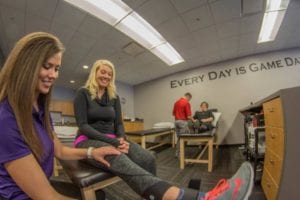As the new year has approached, some may have set New Year’s resolutions that may include improving their physical activity, improving their daily eating habits, or a number of things. With people wanting to improve their physical activity or beginning their new work out regime, some new aches or pains may start to arise. A common symptom could come from knee pain which can stem from several different factors. So, let’s talk about the knee joint itself, general knee pain, what can cause it, how to address or improve these symptoms, and determine if further care is needed.
The knee joint comes together between the joining of the femur (thigh bone) and the tibia (lower leg bone); other bones that help make up this joint include the fibula and patella (kneecap). The knee joint has many important ligaments and pieces of cartilage that help the knee function properly which include the anterior cruciate ligament (ACL), posterior cruciate ligament (PCL), medial and lateral collateral ligaments, lateral and medial meniscus, and several bursae (fluid-filled sacs) that help the knee move smoothly throughout its range of motion.
What is knee pain?
Knee pain can be described various ways depending on the severity of the injury or cause of the symptoms; they can be described as sharp, dull/aches, “locking or catching”, or may have an increase of swelling within the joint. Knee symptoms can be caused from several different factors including change in activity level, lack of ROM, weakness in muscles around the joint that help support movement, and general wear and tear over time. Onset of these symptoms can also start due to poor body mechanics that can put an increased amount of stress onto the knee joint; such as squatting and lifting mechanics.
How to diagnose your knee symptoms?
If your knee symptoms start to affect your daily routines and activities, it is likely time to make an appointment with a healthcare provider for further examination of what is causing these symptoms. Some ways to exam the knee is by x-ray, MRI, or special tests performed by doctors or physical therapists. Your healthcare provider will also ask some questions to help determine the cause of these new symptoms and to help provide a diagnosis of the knee; some of these questions may include: 1) How long have these symptoms been occurring? 2) Was there an exact time or movement that caused a sharp pain or “popping” and symptoms started? 3) Have you tried any NSAID’s (nonsteroidal anti-inflammatory drugs) or ice at home to improve symptoms?
How can physical therapy help?
Your primary physician may suggest attending physical therapy based on their findings. Your first physical therapy appointment would consist of an evaluation by a physical therapist that would assess ROM, strength, perform special tests on the joint, analyze gait pattern, and make a plan of care based off of those initial findings. Within that plan of care, the therapist would make long- and short-term goals to help return the patient to their normal daily activities and
hobbies. A physical therapy session could consist of strengthening and proprioception exercises, improving flexibility, manual therapy techniques if needed, and modalities to help treat any soreness or inflammation within the joint. Re-assessments will be taken periodically to determine any progress made compared to your first session. At the conclusion of your therapy time, the patient would be provided with a home exercise program to continue after they are discharged to maintain the progress made throughout therapy and to help prevent the onset of these symptoms re-occurring in the future.
Abbey Schueth, PTA

